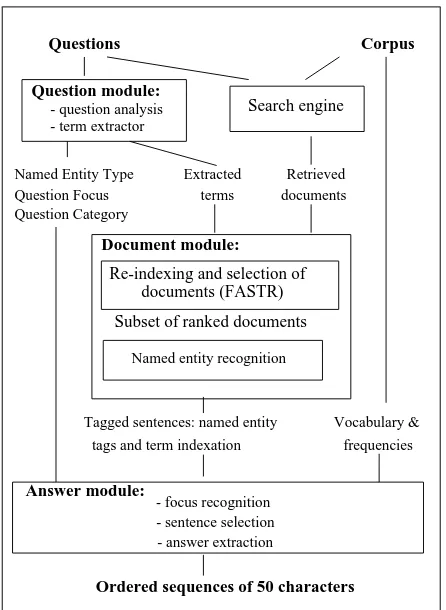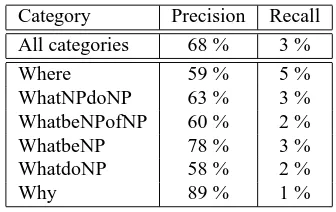Cooperation between black box and glass box approaches for the evaluation of
a question answering system
Martine Hurault-Plantet , Laura Monceaux
LIMSI-CNRS
Bat. 508, Universite Paris XI, 91 403 Orsay, France
mhp, monceaux @limsi.fr Abstract
For the past three years, the question answering system QALC, currently developed in our team, has been taking part in the Question Answering (QA) track of evaluation campaigns TREC (Text REtrieval Conference). In the QA track, each system is evaluated according to a black box approach: as input, a set of questions, and as output, for each question, five answers ranked with regard to decreasing relevance. A score is then computed with regard to the correctness of the answers. Such an evaluation is attractive for comparing systems to each other, as well as for comparing a system to itself after a modification. However, the capacity for knowing how to improve the system requires another approach: the glass box approach. Indeed, in complex modular systems such as question answering systems, we have to ”enter” inside the system and evaluate each module in order to assess if it reaches the goal that has been set for it, or not. Nevertheless, after modifying a module, we have to apply again the back box approach on the whole system in order to judge the effect of the modifications on the overall result. In this paper, we thus present an evaluation of our system, based both on black box and glass box approaches. We will describe the methods used as well as the results that we obtain.
1.
Introduction
For the past three years, the question answering sys-tem QALC (Ferret et al., 2001b), currently developed in our team, has been taking part in the evaluation campaigns TREC (Text REtrieval Conference) organized by NIST1 (National Institute of Standards and Technology). The Question Answering (QA) track of TREC involves search-ing for answers to a list of questions, within a collection of documents provided by NIST. Questions are factual or encyclopaedic, while documents are newspaper articles.
In the QA track, each system is evaluated according to a black box approach: as input, a set of questions, and as output, for each question, five answers ranked with re-gard to decreasing relevance. Answers have to be short, less then 50 characters, and have to include the number of the document from which each of them has been retrieved. Human judges decide on the correctness of each answer. Global evaluation of each system is then computed with re-gard to both this judgment and the ranking of the correct answer among the five answers provided for each question (Voorhees and Tice, 2000).
Such an evaluation is attractive for comparing systems to each other, as well as for comparing a system to itself af-ter a modification. However, the capacity for knowing how to improve the system requires another approach: the glass box approach. Indeed, in complex modular systems such as question answering systems, we have to ”enter” inside the system and evaluate each module in order to assess if it reaches the goal that has been set for it, or not. Neverthe-less, after modifying a module, we have to apply again the back box approach on the whole system in order to judge the effect of the modifications on the overall result. Both approaches, black box and glass box, have already been used in the evaluation other modular complex systems such as dialog systems (Simpson and Fraser, 1993).
In this paper, we thus present an evaluation protocol
1
http://trec.nist.gov/
combining the black box and the glass box approaches. In the following section, we describe the QALC system and the methodology of evaluation. We then present the results of the black box evaluation of the whole question corpus and for each question category. Afterwards, we present the evaluation of each module of the system, focusing on the most interesting categories, i.e. those which have some salient feature of size or of behaviour. Finally, we dicuss the main results of the evaluation of the system, and we end with a few concluding remarks.
2.
Evaluation framework
2.1. System architecture
The QALC system is made of three main modules, one devoted to the processing of the questions, another one to the corpora, and the last module which extracts the answer from the documents by using the informations collected by the two other modules. Each of these modules includes a number of processes (see Figure 1).
2.1.1. Question processing module
This module includes a question analysis process and a term extractor. The term extractor is based on syntactic patterns which describe compound nouns. The maximal extension of these compounds is produced along with the plausible sub-phrases. All the noun phrases belonging to this maximal extension are also produced.
The analysis of the question reasons about the outputs of a shallow parser in order to extract a number of informa-tions from the question:
Category Example Number of questions Score
Where Where is the Holland Tunnel? 27 0.316
When When did Hawaii become a state? 26 0.280
WhatNPdoNP What year did the U.S. buy Alaska? 24 0.272
Who Who discovered x-rays? 46 0.254
WhatbeNPofNP What is the melting point of copper? 47 0.247
How How long did Rip Van Winkle sleep? 33 0.192
WhatbeNP What is acupuncture? 199 0.189
WhatNPbeNP What precious stone is a form of pure carbon? 47 0.182 WhatNPverbNP What strait separates North America from Asia? 6 0.167
Which Which president was unmarried? 10 0.100
WhatdoNP What does a barometer measure? 22 0.027
Why Why does the moon turn orange? 4 0.000
Table 1: Evaluation of the overall system for each question category
rectness of the answer and on its rank (Voorhees and Tice, 2000). This score is derived from the mean reciprocal rank of the first five answers. For each question, the first correct answer, among the first five answers, get a mark in reverse proportion to its rank. The score for all the questions is the mean of the question marks. Thus, we obtain an evaluation of the whole system for each subset of questions. This first evaluation enables us to know for which sets of questions the system is effective, but it does not explain why. There-fore, the next step consists of a glass box approach applied to sets of questions, and especially to those that have been previously marked as less effective.
The glass box approach consists of an evaluation of each module of the system according to a criterion adapted to the data given as input and to the results provided as out-put. Thus, according to the different modules, either the recall and precision measures were used, or the score de-fined by TREC.
We used recall and precision measures for both the question analysis and document selection modules. The question corpus was tagged by hand, and we judged the re-sults with regard to this reference corpus. It should be noted that we did not evaluate named entity recognition within the documents. Indeed, for this purpose, we would have had to tag by hand the document corpus. We did it for the 500 questions of the TREC10 corpus, but we could not do it even for a large subset of the document corpus. Con-cerning the evaluation of the document selection, we used the reference data provided by the NIST. Indeed, the NIST provides the list of correct answers found by participants to TREC, and the documents where they have been retrieved, after each TREC conference it organizes. The NIST also provides the patterns of correct answers and a code which computes the score of the system. Concerning the sentence selection and answer extraction modules, we then used the score defined by TREC, so as to evaluate those modules in terms of the correct answers retrieved, either within the sentences, or in the final answers (less than 50 characters). In addition to the evaluation of each module, we performed a specific evaluation of the extraction patterns used in the answer extraction module, in order to assess the pattern rel-evance with regard to each question category.
3.
Black box evaluation of the system
We present in table 2 the score obtained by the run that was sent to TREC10 evaluation. Strict and lenient scores correspond to the two judgements provided by hu-man judges of the conference. These scores are slightly lower than the one computed with the code and data pro-vided by the NIST. Indeed, computer matching of answer pattern cannot completely insure the correctness of the an-swer. It may happen that, although the correct words are retrieved, the document context shows that they do not con-stitute a correct answer.Evaluation strict lenient automatic TREC10 0.181 0.192 0.205
Table 2: Evaluation of the overall system
The score of the system is rather weak. In order to better determine the weak points, we performed an evaluation of the overall system, for each question category.
The categories that we obtain from the question anal-ysis module, are of very dissimilar size, from 2 questions for the smallest to 182 for the biggest. For more clear-ness, we brought together categories which had a number of shared caracteristics so as to create 12 sufficiently homo-geneous categories. Nevertheless, we have to keep in mind that these categories include more specific sub-categories that we study with more detail in particular cases. Table 1 presents the score of the system attached to each question category, in decreasing order of the scores.
The WhatbeNP category has the biggest size. It includes a number of low size categories (such as WhatbeNPforNP for instance) that do not appear in the table. Only the
What-beNPofNP appears because of its bigger size. Among the
492 questions from TREC10, only one is not taken into ac-count in our statistics : What causes gray hair?, the only one instance in its category (WhatverbNP).
In this first approach, we note that the best scores are obtained by categories corresponding to a named entity. Ei-ther categories whose expected answer is, with very few ex-ceptions, a named entity, (Where, a location, When, a date,
C. Jacquemin. 1999. Syntagmatic and paradigmatic repre-sentations of term variation. In Proceedings of ACL’99, 1:341–348.
A. Simpson and N. Fraser. 1993. Black box and glass box evaluation of the sundial system. In Proceedings of
the 3rd European Conference on Speech Communication and Technology, pages 1423–6.
E. Voorhees and D. Tice. 2000. Implementing a ques-tion answering evaluaques-tion. In Proceedings of the second




